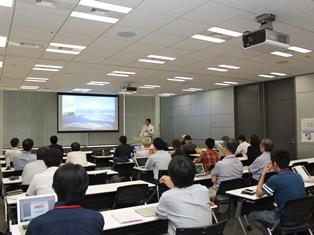イベント開催報告 グローバルエコノミー
経済・社会への分野横断的研究会
2017年9月25日(月)
10:00
~ 18:10
& 26日(火)10:00~14:45
開催
会場:キヤノングローバル戦略研究所 会議室3
プログラムPDF:277KB


開会挨拶
福井 俊彦
キヤノングローバル戦略研究所 理事長
招待講演Ⅰ
-
「次世代スパコンと社会シミュレーション」
発表者:
伊藤 伸泰(東京大学大学院工学系研究科・理化学研究所(AICS))
「京」コンピュータと次世代のエクサフロップス級のスーパーコンピュータによる社会現象のシミュレーションに向けた現状と展望を議論する。現在、複数の社会現象の連成現象を念頭に、秒単位よりも高速の為替・証券取引から十年単位の経済活動までの連成や、広域交通・広域避難、経済と物流・地域社会との連成ほかの研究をすすめている。こうしたシミュレーションモデルには莫大な数のパラメータがあり、また問題の究明には莫大な数のシミュレーションが必要となる。このため、モデルの開発のみならずそのシミュレーション技術、特にパラメータや条件探索の高度化が重要と考えている。
発表資料PDF:7.83MB
Session 1 Chair: 水野 貴之(国立情報学研究所情報社会相関研究系、CIGS)
-
「企業間取引ネットワークにおける階層構造」
発表者:
吉川 悠一(新潟大学理学部)
共同研究者:
家富 洋(新潟大学理学部)
飯野 隆史(新潟大学理学部)
井上 寛康(兵庫県立大学大学院シミュレーション学)
我が国における実体経済は、約100万社の企業間の数百万の取引関係によって特徴づけられる。このようなミクロの企業間の関係は、企業をノード、取引関係をリンクとした有向ネットワークとして表される。本研究では、最新の日本の企業間取引関係データを(東京商工リサーチ社製,2016年)に対して実証的な解析を行った。Map Equation法によるコミュニティ分割とHelmholtz-Hodge分解による取引流の分解によって、企業間の取引関係ネットワークを企業同士が双方向に強く結びついている部分と、取引の流れが偏った階層的な部分とに分解した。これにより、階層性を含めた業種同士の関係性を読み取ることができる。結果、同じ業種内においても企業は上流から下流にわたって幅広く分布していることがわかった。この結果は、経済構造の分析にあたっての産業分類の限界を示唆している。
-
「三角貿易構造の抽出とその変遷」
発表者:
武田 正俊(新潟大学大学院自然科学研究科)
共同研究者:
吉川 悠一(新潟大学理学部)
家富 洋(新潟大学理学部)
近年、グローバリゼーションの影響により、貿易ネットワークの複雑化が進んできている。それに伴い、貿易関係の視座を2国間から多国間へと移すことが必要になってきた。そこで多国間貿易の中で最も簡単な例である三角貿易について考える。
本研究では、Her_ndahl-Hirschman Index(HHI) を用いて貿易収支から見た安定的な三角貿易関係の抽出、及び得られた三角貿易関係の品目による特徴づけなどの結果を報告した。
Session 2 Chair: 佐藤 彰洋(京都大学大学院情報学研究科、CIGS)
-
"How firms choose their partners in the Japanese production network?"
発表者:
Hazem Krichene (Graduate School of Simulation Studies, University of Hyogo)
共同研究者:
Yoshiyuki Arata (RIETI(The Research Institute of Economy, Trade and Industry))
Abhijit Chakraborty (University of Hyogo)
Yoshi Fujiwara (University of Hyogo)
Hiroyasu Inoue (University of Hyogo)
This work aims at explaining how Japanese firms choose the set of their suppliers and customers. We considered the production network of the TSR data and we selected only firms which belong to the Tokyo Stock Exchange. The network size is 3,198 firms with 20,514 links. To achieve our analysis, we applied the Exponential Random Graph Model (ERGM) technique. This technique requires a high computational time, and always applied on small network (around 100 nodes). Therefore, the main contribution was the development of a Python code of ERGM technique based on a very fast sampling algorithm (Improved Fixed Density MCMC, Byshkin et al. (2016)). The estimation of this network showed that the Japanese firms choose their partners based on social attributes, i.e. the attributes related to the network topology, and based on economic attributes. By social attributes, we showed that links are more probable with mutual relationships (reciprocity) and common neighbor relationships (transitivity). Moreover, more active and popular firms tend to be more active and popular (in and out degrees). On the other hand, based on the economic attributes, we found that links are more probable between firms which belong to same sector and same location.
発表資料PDF:1.25MB
-
"Leverage Effect and Multifractality for stock price process"
発表者:
黒田 耕嗣(日本大学大学院総合基礎科学研究科)
株価の変動を表す確率過程が満たすべき条件として、 (1) Multifractalityと(2) Leverage Effectの二つが株価実証研究から要請されている。数理ファイナンスにおいては株価(またはlog -retun process)を表す確率過程としてSt = μt + σBt といったものが用いられている。 μはdrift係数で、Bt はブラウン運動である。ブラウン運動に関してはtime-lagがΔtの変動ΔBt = Bt+Δt - Bt の分布は(Δt)1/2W (W~N(0,1))と表される。すなわちブラウン運動は(Δt)1/2の変動モードを持っている。しかし、実際の株価変動過程は、時間帯によって複数の変動モードを持つことが知られている。これを株価のMultifractalityとよび、(Δt)αの変動モードが現れる頻度を表すものとしてMultifractal spectrum f(α)というものが知られている。
一方、Leverage Effectとは現時点の株価変動と将来のvolatilityは負の相関があるが、現時点のvolatilityと将来の株価変動とは相関がないということである。これらの条件を満たす確率過程の数学的な構成は、独立なrandom mediaに対してBacr-Muzy達によってなされている。本研究の目的はinvestment time horizonという概念を数学的にmodelの中に導入し、逆べきの相互作用をもつrandom mediaにおいて、二つの条件をみたす確率過程を構成することにある。この構成に当たっては、まず離散時間モデルを定め、Abstract Polymer expansionの手法を用いて、そのスケール極限としてlog-volatility processをガウス過程として導き、このガウス過程を用いて株価変動過程を表す確率過程を構成した。
発表資料PDF:0.99MB
-
「古代メソポタミアにおけるfamily networkと経済・社会活動:人名史料の電子化と解析」
発表者:
上田 澄江(統計数理研究所)
共同研究者:
土谷 隆(政策研究大学院大学)
伊藤 栄明(統計数理研究所、総合研究大学院大学)
古代メソポタミアにおけるヌジ遺跡から約4000枚の文書が出土している。主に土地など財産の売買・貸与・貸付、結婚、訴訟に関する契約文書である。この文書から構成された最大のテヒプティラの家系図は6世代にわたっていてヌジの存続期間を網羅するものである。ここで用いた"Nuzi Personal Names"はヌジ文書の索引で、ヌジ名の親族関係と登場する文書名が参照できる。契約内容を知ることはできない。ここから家系図を構成し、最大の家系図のネットワークを利用して、最適化の問題として定式化することにより文書の成立年と個々の人物の生誕年・死亡年を推定した。我々の結果と、M.P.Maidmanの研究を融合させ、個々の契約時における人物の年齢を推定し、より整合性のあるパラメータを探る。ヌジ文書は時代を特徴づける情報の宝庫である。"Nuzi Personal Names"がその索引として有用な役割を果たせるよう電子化を進めている。
原著論文(掲載ページ)※外部サイトに移動します
"Logistic growth for the Nuzi cuneiform tablets: Analyzing family networks in ancient Mesopotamia" (S.Ueda, K. Makino, Y. Itoh, T. Tsuchiya)
Session 3 Chair: 久野 遼平(東京大学大学院情報理工学系研究科、CIGS)
-
「データ分析を社会のシミュレーションに利用する」
発表者:
佐藤 彰洋(京都大学大学院情報学研究科、CIGS)
社会をシミュレートする場合、取り扱おうとする社会現象の詳細な理解が必要となる。その場合、データ分析と社会シミュレーションとを併用しながら対象に対する理解とデータ規模、モデルの精度をCAPDサイクルに基づき高めていく方法が有効である。本講演では、社会シミュレーションの目的(説明、予想・推定、設計)に応じて直面する諸課題を整理するとともに、データ分析の結果を社会のシミュレーションに利用する方法について説明する。更に、航空機輸送の問題に対して、データ分析の結果をシミュレーションに利用するために行った研究の事例を紹介し、社会のシミュレーションを行うときに取り扱うべき課題について議論する。
発表資料PDF:1.99MB
-
「多段階モデルを使ったがんデータの解析」
発表者:
真鍋 勇一郎(大阪大学大学院工学研究科)
共同研究者:
和田 隆宏(関西大学システム理工学部)
坂東 昌子(大阪大学核物理研究センター)
放射線の生体影響を機序を考慮したモデルによって定量評価することは従来からの課題である。
これまでに動物・植物についての放射線誘発突然変異の実験データを解析し、機序を考慮したもぐらたたきモデルでおおむね再現できることを示した。
しかしながら、放射線のリスクは放射線によって誘発されるがんが主眼であるので、がんのリスクを定量評価したい。今回は研究の端緒として放射線によらないがん、特に発見される年齢と発生数が比較的そろっており、がんになるまでの突然変異の段階が少ない2段階モデルで再現できると言われている網膜芽細胞腫のデータを扱う。
その結果、一般的に成立すると言われている2段階モデルは単純なモデルを仮定すると成立せず、むしろ時間によって突然変異が増えると考えないと成立しないことが分かった。今後より複雑な2段階モデルを仮定し、データの再現を目指す。
-
「マウスにおける放射線による寿命短縮の数理的解析」
発表者:
和田 隆宏(関西大学システム理工学部)
共同研究者:
真鍋 勇一郎(大阪大学工学研究科)
坂東 昌子(大阪大学核物理研究センター)
環境科学技術研究所では、同一種のマウスに対して、成長のある時期に継続的に低線量率の放射線を照射する実験を行っており、大きく2種類のデータが得られている。ひとつは、マウスを定期的に解剖して、体内にあるがんの数を数えたもので、もうひとつは、マウスを死亡するまで飼い続けたものである。前者では、照射群では非照射群に比べてがんの発生が早まり、また平均のがんの発生数も多いという結果を得ており、一方、後者では、線量率の増加に伴って寿命の短縮が見られている。
我々は、飼育環境でのマウスの死亡はがんによるものであるとの仮定の下に、がんの発生と成長、がんによる死亡を計算するモデルを構築し、データの解析を行った。放射線によるがん発生率の変化と寿命短縮の関係を解析することで、がんのメカニズムに対する理解を深めるのが本研究の目的である。
発表資料PDF:678KB
Session 4 Chair: 大西 立顕(東京大学大学院情報工学系研究科、CIGS)
-
「ホークス過程の高頻度金融時系列データへの応用」
発表者:
近江 崇宏(東京大学生産技術研究所)
共同研究者:
平田 祥人(東京大学生産技術研究所)
合原 一幸(東京大学生産技術研究所)
近年、高頻度金融時系列において価格変動が起こるタイミングをHawkes過程を用いてモデル化することがよく行われるようになってきた。最近我々はHawkes過程のバックグラウンドレートが時間に依存して変動するモデルを導入し、それのベイズ推定手法を構築した。本講演では、日経225miniのデータに対して本モデルを適用した結果についての報告を行う。
詳細な結果はT. Omi, Y. Hirata, and K. Aihara, "Hawkes process model with a time-dependent background rate and its application to high-frequency financial data", Physical Review E 96, 012303 (2017)を参考にされたい。
-
"Quantized price volatility model for transaction data"
発表者:
森谷 博之(Quasars22)
日経225miniの先物市場では、取引が成立するとき、その前の約定価格と同じ価格で取引が成立する非緊急性取引の数は全体の8割近くに達する。マーケットメイカー(MM)が作り出すビット・アスク・バウンスの影響を受けた値動きも非緊急性取引と判断するとその数は9割を大きく超える。したがって、値動きを伴う緊急性を要する取引の数は、全体の数%となる。また、通常の市場では、連続した緊急性取引の約定価格の差を2乗したものの累積和(sum of squared price increments: sspi)は、安定性していることが分かっている。つぎに、市場に流動性を供給するMMは常に逆選択リスクに曝され、安定した収益の確保が難しく、かつ、投資家は、投資の開始時と終了時の取引費用の最小化に困難を見出している。そこで、緊急性取引から生じる価格の動きの特徴を調べてみたところ、将来の価格の動きはおおむね予測不能であることが分かった。ゆえに、このような状態に置かれたMMと投資家は、それぞれの投資行動を最適化するために活動し、その相互作用により、非緊急性取引の数が極端に多くなり、またsspiが安定するのではないかという仮説を考察した。
発表資料PDF:1.41MB
-
「ティックデータを用いた取引コスト推計」
発表者:
水野 貴之(国立情報学研究所金融スマートデータ研究センター、CIGS)
共同研究者:
山田 健太(国立情報学研究所金融スマートデータ研究センター)
東京証券取引所に上場する時価総額上位500社について、1日の売りと買いの約定量の差とリターンとの関係から銘柄別の取引コストを推計した。取引コストは銘柄に強く依存する一方、各銘柄の時系列方向には、取引コストは年単位でもそれほど変化しないことが明らかとなった。
招待講演Ⅱ
-
「新しいマクロ経済学」
発表者:
吉川 洋(立正大学経済学部、CIGS)
代表的消費者/企業の最適化に基づく micro-founded macroeconomics は不毛なアプローチである。
マクロ経済学の正しいミクロ的基礎づけは統計物理学的方法であることを説明する。
発表資料PDF:1.33MB
Session 5 Chair: 渡辺 広太(東京大学大学院経済学研究科、CIGS)
-
「ツイッターデータを用いた意識の違いによる人の行動パターン分析」
発表者:
石川 温(金沢学院大学経営情報学部)
共同研究者:
藤本 祥二(金沢学院大学経営情報学部)
水野 貴之(国立情報学研究所情報社会相関研究系、CIGS)
本研究では、日本における約1年間の位置情報付きツイートデータを用いて、ツイッターユーザのツイート拠点の分布を観測した。そして、その分布と国勢調査の人口分布を比較し、両者が非常に強い相関を持つことを示した。同時に、ツイート拠点でツイートする確率の1日の時間変化を観測し、それをNHK放送文化研究所が調査した起床在宅率の時間変化と比較した。そして、両者の時間変化のパターンも非常に似ており、特に平日における再現性が高いことを示した。
発表資料PDF:824KB
-
「人・店舗・施設の時空間ビッグデータを用いた地域の特徴づけ」
発表者:
大西 立顕(東京大学大学院情報理工学系研究科、CIGS)
共同研究者:
水野 貴之(国立情報学研究所情報社会相関研究系、CIGS)
渡辺 努(東京大学大学院経済学研究科、CIGS)
緯度経度・業種情報付き電話帳データを用いて、市区町村(町・大字)毎に様々な店舗・施設の個数を計測した。他の市区町村(町・大字)との比較の観点から、真に人口に見当った店舗・施設数になっているかを市区町村(町・大字)毎に定量化する指標を開発した。さらに、各市区町村(町・大字)の消滅可能性の指標を定義できる可能性も検討した。次に、全国の国民一人一人について最寄りの食料品・飲食店、病院・医療機関、スーパーなどの施設がどのくらい離れた距離に存在しているかを調べた。国勢調査100mメッシュ推計データ、緯度経度・業種情報付き電話帳データ、日本スーパー名鑑ポイントデータを用いて、100mメッシュ単位で最寄りの様々な施設までの距離を年齢別に算出した。算出した距離を地図上に可視化し、指標として活用できるか検討した。携帯機器の出現により、人の移動履歴(周遊行動)に関する情報が高精度かつ広範囲に観測できるようになった。しかし、携帯電話のデータはプライバシーの問題で利用が制限されるため、分析に用いることは難しい。ソーシャルメディアのデータであれば、国や地域を限定することもなく世界規模で利用が可能である。そこで、緯度経度・ID情報付きTwitterデータを用いて、都市間の人の移動を表わす重みつきネットワークを作成した。作成したネットワークから二都市間の関係性の強さを定量化し、都市と都市の関係性を表す指標を開発し、妥当性を検討した。
-
「時空間ビッグデータによる地域政策の可能性」
発表者:
水野 貴之(国立情報学研究所情報社会相関研究系、CIGS)
共同研究者:
大西 立顕(東京大学大学院情報理工学系研究科、CIGS)
水野が分担者として参加する千葉市と東京大学とのビッグデータ活用に関する共同研究(研究代表者:大西立顕)の成果について紹介した。Geoタグ付きTweetの位置情報とTwitterユーザーに対するプロファイリングを使うことによって低コストに属性別の流動人口調査や施設への来訪者調査が可能であることを示した。また、複数の動物園を対象に場所に対するポジティブフィードバックが存在することを示した。さらに、スマートフォンの移動履歴ビッグデータによる社会調査例を示し、組織やコミュニティに関する情報保護について問題を提起した。
-
「サプライチェーン途絶の影響:東日本大震災における推定」
発表者:
楡井 誠(東京大学大学院経済学研究科)
共同研究者:
Vasco M. Carvalho (University of Cambridge)
Yukiko Saito (RIETI(The Research Institute of Economy, Trade and Industry))
Alireza Tahbaz-Salehi (Northwestern University)
現代経済において中間投入財は総産出の約半分を占め、 付加価値(GDP)に匹敵する規模をもつ。中間投入財は企業間ネットワークの精妙な働きによって供給されており、サプライチェーンの乱れは複雑な経路を通じてマクロ経済に影響を及ぼす可能性がある。本論文では、東日本大震災に直接被災した企業の波及効果を、企業間取引ネットワークデータを用いて推定した。推定によれば、波及効果は被災企業の川上企業よりも川下企業に大きく、一次の顧客において平均2%、二次・三次の顧客において1.3%の売上高減少が確認された。これらのミクロの影響を集計すると、日本の総産出の1.2%に相当する。このようにマクロの効果がミクロの効果と同じ規模になるのは、企業間ネットワークが稠密であるために、被災企業数が少なくても、ネットワーク上で間接的なつながりをもつ企業数が膨大になるからである。報告では、マクロ経済におけるネットワーク効果を紹介したほか、社会科学の実証研究における因果性推定の考え方についても議論した。
原著論文(掲載ページ)※外部サイトに移動します
"Supply Chain Disruptions: Evidence from the Great East Japan Earthquake" (Vasco M Carvalho, Makoto Nirei, Yukiko U. Saito, Alireza Tahbaz-Salehi)
-
「企業ネットワークにおける張替え効果の推計とそのマクロ的帰結」
発表者:
久野 遼平(東京大学大学院情報理工学系研究科、CIGS)
共同研究者:
Didier Sornette (ETH(Eidgenössische Technische Hochschule) Zurich, Swiss Finance Institute)
水野 貴之(国立情報学研究所情報社会相関研究系、CIGS)
大西 立顕(東京大学大学院情報理工学系研究科、CIGS)
渡辺 努(東京大学大学院経済学研究科、CIGS)























